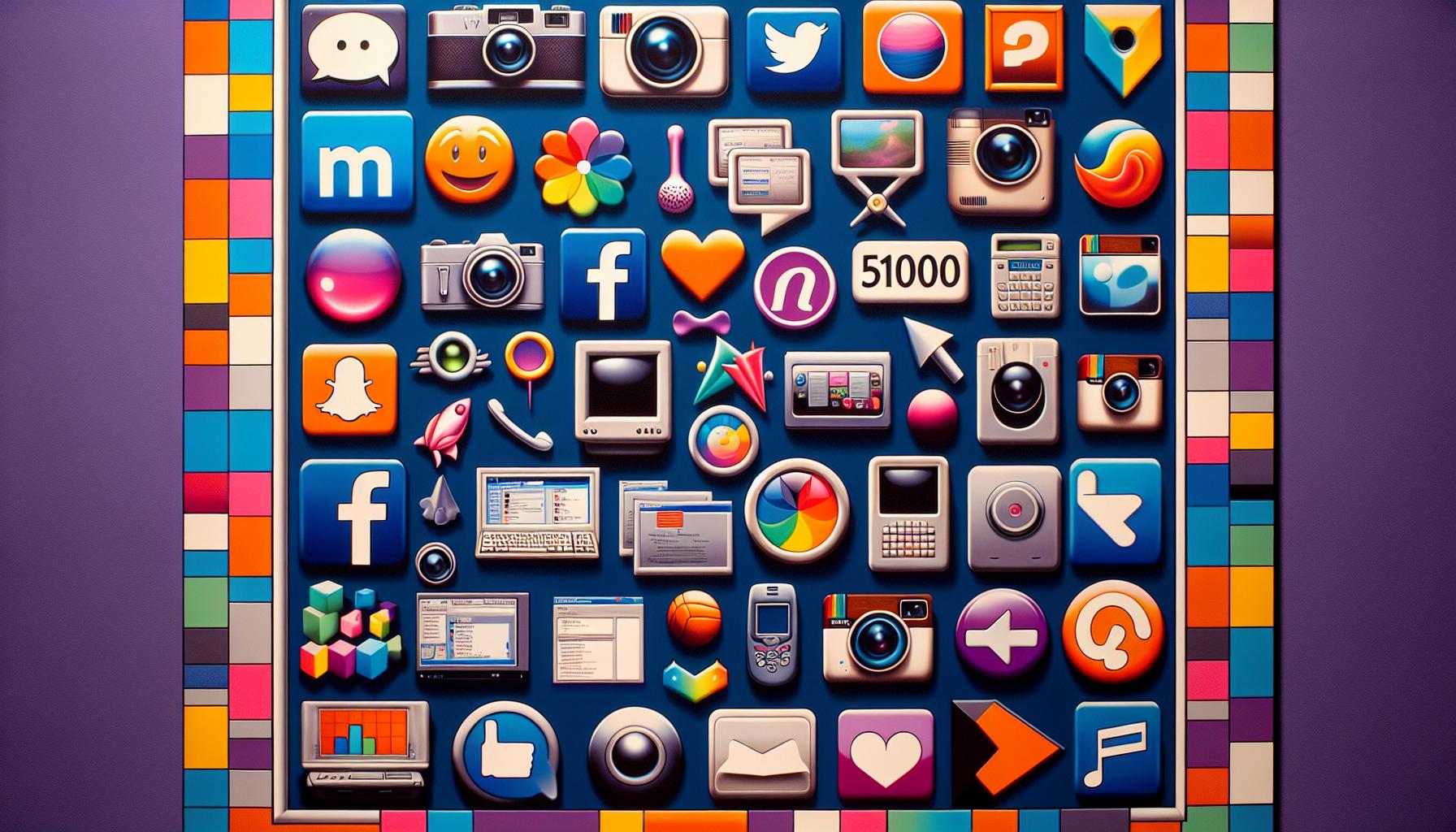
20 Forgotten Social Media Apps That Defined the Early Internet Era
Social media platforms have transformed how people connect interact and share their lives online. While today’s digital landscape is dominated by giants like Instagram and TikTok many pioneering social networks paved the way for modern social communication.
Remember Friendster MySpace and Hi5? These early social media platforms were revolutionary for their time attracting millions of users in the early 2000s. They introduced features we now take for granted like personal profiles photo sharing and the ability to connect with friends online. Though most of these platforms have faded into digital history they’ve left an indelible mark on how social media evolved into what it is today.
The Rise and Fall of Early Social Networks
Early social networks transformed online communication between 2002-2008, creating foundational features that modern platforms use today. These pioneering platforms attracted millions of users before facing rapid declines due to technical limitations and emerging competition.
Friendster’s Pioneer Status
Friendster launched in 2002 as the first mainstream social networking platform, reaching 3 million users within three months. The platform introduced core social networking concepts like profiles, friend connections and testimonials. Its infrastructure struggled to handle rapid user growth, causing slow loading times and frequent outages. By 2006, Friendster’s technical limitations led to a mass exodus of users despite having over 115 million registered accounts.
| Friendster Statistics | Numbers |
|---|---|
| Peak Users (2008) | 115 million |
| Launch Year | 2002 |
| Initial Growth | 3 million in 3 months |
| Patent Sale Value | $40 million |
MySpace’s Cultural Impact
MySpace dominated social media from 2005-2008, reaching 75.9 million monthly active users at its peak. The platform revolutionized online self-expression through customizable profiles, blog posts and embedded music players. MySpace became a launching pad for musicians like Arctic Monkeys, Lily Allen and Sean Kingston. News Corporation acquired MySpace for $580 million in 2005, but user engagement declined significantly after Facebook gained popularity.
| MySpace Milestones | Data |
|---|---|
| Peak Users (2008) | 75.9 million |
| Acquisition Price | $580 million |
| Launch Year | 2003 |
| Sale Price to Time Inc | $35 million |
Forgotten Social Media Platforms of the 2000s


The mid-2000s witnessed the rise of several social networking platforms that captured millions of users worldwide before fading into obscurity. These platforms introduced unique features and catered to specific regional markets during the early days of social networking.
Hi5 and Tagged
Hi5 launched in 2003 and reached 50 million active users by 2008, establishing itself as one of the top three social networks globally. The platform distinguished itself with features like “friend rankings” and customizable profile designs. Tagged acquired Hi5 in 2011 for an undisclosed amount, combining both platforms’ user bases to create a social discovery network focused on meeting new people rather than connecting with existing friends.
| Platform Statistics | Hi5 | Tagged |
|---|---|---|
| Launch Year | 2003 | 2004 |
| Peak Users | 50M (2008) | 100M (2011) |
| Primary Markets | Latin America Asia | United States |
| Notable Features | Friend Rankings Profile Customization | Virtual Gifts Meet Me Game Features |
Orkut’s Global Journey
Orkut, launched by Google in 2004, gained massive popularity in Brazil India where it captured 80% of all social media users. The platform’s unique features included:
- Scraps: A casual messaging system for public wall posts
- Communities: Topic-based groups with forums discussions
- Testimonials: Personal recommendations from friends displayed on profiles
- Trust Ratings: Metrics showing user reliability friendship levels
Despite reaching 300 million registered users, Orkut shut down in 2014 when Google shifted focus to Google+. Brazil remained Orkut’s largest market with 54% of all users, followed by India at 27% until its final days.
| Orkut Market Share | Percentage |
|---|---|
| Brazil | 54% |
| India | 27% |
| United States | 6% |
| Others | 13% |
Messaging Apps That Shaped Communication
Early messaging apps revolutionized digital communication by introducing real-time chat features text formatting options. These platforms laid the groundwork for modern instant messaging services through innovative features like emoticons file sharing capabilities.
MSN Messenger’s Legacy
Microsoft’s MSN Messenger dominated online communication from 1999 to 2013, reaching 330 million active users at its peak. The platform introduced groundbreaking features like custom emoticons, animated display pictures “nudges” to get attention. Users expressed themselves through personalized status messages colorful screen names while chatting in multiple windows simultaneously. MSN Messenger integrated with Xbox Live in 2007, enabling cross-platform gaming chat.
| MSN Messenger Statistics | Numbers |
|---|---|
| Peak Active Users | 330 million |
| Launch Year | 1999 |
| Final Year | 2013 |
| Supported Languages | 50 |
AOL Instant Messenger (AIM)
AIM pioneered instant messaging from 1997, attracting 18 million simultaneous users during its height in 2001. The platform introduced iconic features like away messages, buddy lists profile customization with “buddy icons.” AIM’s distinctive door-opening sound effect door-closing logout alert became cultural touchstones. The service offered chat rooms organized by interests topics, creating online communities centered around shared interests.
| AIM Statistics | Numbers |
|---|---|
| Peak Simultaneous Users | 18 million |
| Launch Year | 1997 |
| Final Year | 2017 |
| Active Users (2011) | 36 million |
How Early Social Media Changed Society
Early social media platforms fundamentally transformed how people connect interact online between 2002-2008. These platforms introduced revolutionary concepts that shaped modern digital communication patterns.
Digital Identity Evolution
Early social networks introduced the concept of digital self-representation through customizable profiles. Users created online personas using profile pictures, personal information sections, interests lists, and custom backgrounds. MySpace’s HTML customization allowed users to express individuality through unique layouts, backgrounds, and music players. This digital identity creation established the foundation for modern personal branding on platforms like LinkedIn and Instagram.
| Platform | Key Identity Feature | Peak Users |
|---|---|---|
| MySpace | HTML Profile Customization | 75.9M |
| Friendster | Profile Testimonials | 115M |
| Hi5 | Friend Rankings | 50M |
- Interest-based groups for connecting users with shared passions
- Public forums enabling discussions between strangers
- Community moderation tools for maintaining content quality
- Real-time chat rooms facilitating instant communication
- Photo sharing capabilities for visual content exchange
| Community Feature | Platform Pioneer | Year Introduced |
|---|---|---|
| Topic Groups | Orkut | 2004 |
| Public Forums | Friendster | 2002 |
| Photo Albums | MySpace | 2003 |
Impact on Modern Social Networks
Early social networks created fundamental features that define today’s digital landscape. Instagram’s photo-sharing capabilities stem from Friendster’s pioneering image galleries. Facebook’s news feed draws inspiration from MySpace’s bulletin system. Twitter’s character limit reflects AIM’s text constraints.
Feature Evolution
- Profile customization evolved from MySpace’s HTML editing to Instagram’s filtered aesthetics
- Messaging systems transformed from MSN’s basic chat to WhatsApp’s multimedia communication
- Status updates progressed from Orkut’s scraps to Twitter’s real-time microblogging
- Friend networks advanced from Friendster’s connections to Facebook’s complex social graphs
User Engagement Strategies
Modern platforms adopted proven engagement tactics from early social networks:
| Original Feature | Modern Implementation | Platform |
|---|---|---|
| MySpace Top 8 | Close Friends List | |
| AIM Away Messages | Story Updates | Snapchat |
| Hi5 Friend Rankings | Following Lists | |
| MSN Custom Emoticons | Custom Reactions |
Data Management Lessons
Early platform failures taught valuable lessons about:
- Server infrastructure scaling from Friendster’s collapse
- Content moderation practices from MySpace’s decline
- Privacy controls from early messaging apps
- User interface optimization from Hi5’s experience
Community Building Mechanisms
Modern platforms refined community features:
- Interest-based groups evolved into Facebook Groups
- Orkut’s communities inspired Reddit’s subreddits
- MySpace’s music promotion transformed into Spotify’s social features
- MSN’s chat rooms influenced Discord’s server structure
These inherited elements continue shaping user experiences on contemporary social media platforms while incorporating advanced technologies like AI-driven content recommendation systems.
Conclusion
The landscape of social media has undergone remarkable transformations since the early 2000s. While platforms like Friendster MySpace and Hi5 may now be distant memories they’ve left an indelible mark on how we connect online today.
These pioneering platforms introduced features we now take for granted – from customizable profiles to photo sharing and real-time messaging. Their successes and failures have shaped the development of modern social networks like Instagram TikTok and Facebook.
Though these early social platforms are no longer active their legacy lives on in the DNA of contemporary social media. They’ve taught valuable lessons about user engagement platform scalability and the importance of adapting to changing user needs in the ever-evolving digital landscape.



